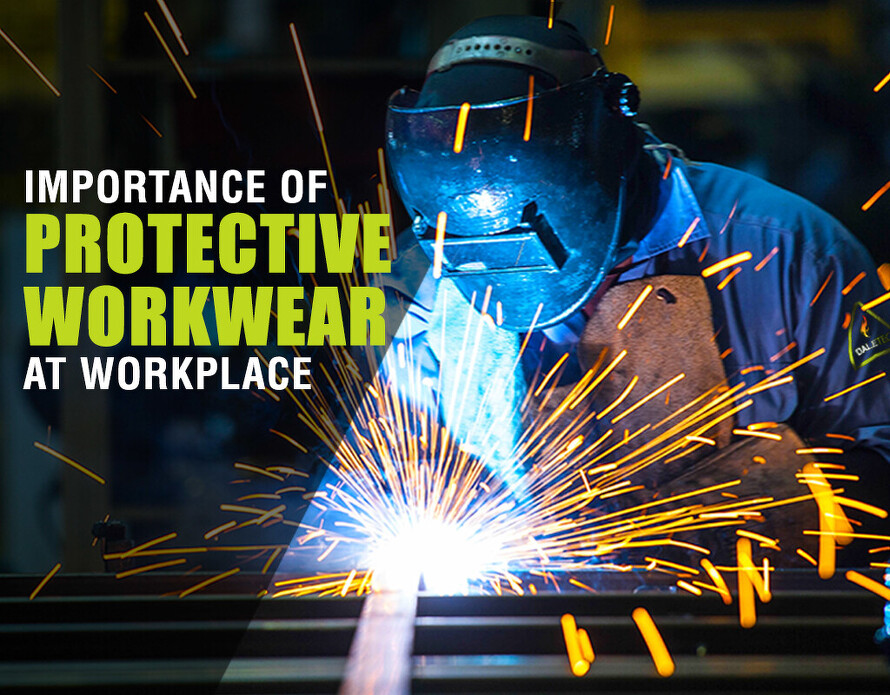IMPORTANCE OF PROTECTIVE WORKWEAR AT WORKPLACE

Accidents in a high-risk workplace setting is a common occurrence but they are not something that can be taken lightly. Whenever an emergency situation arises at a work site such as in mines, oil & gas industry, electrical industry, manufacturing plants, welding industry and chemical industry – it may involve risk to the life of one or more persons as well as damage to machinery and equipment. While machinery and equipment are replaceable, lives are not. This is why it is immensely important to introduce and maintain adequate safety procedures at the workplace, and when it comes to these procedures, personal safety is the first and foremost thing to be considered.
PERSONAL PROTECTIVE EQUIPMENT (PPE)
As is rightly said, “Safety begins with compliance”. In different industries, workers are faced with varied forms of hazards which are not always controllable through any administrative or engineered means. The nature of these hazards could encompass anything from fire to chemical outburst to electrical shock to molten metal splash. In such situations, the importance of personal protective equipment or protective workwear increases manifold.
Personal Protective Equipment involves the use of protective clothing and accessories such as safety goggles, helmets, gloves, protective boots, even earplugs from noise hazards etc.), designed to protect the employees against work hazards. The primary purpose of the protective workwear is not just to observe job-related occupational safety but to also safeguard against health issues such as headaches, respiratory problems, skin problems, etc.
HAZARD ASSESSMENT
There are as many types of work hazards as there are work environments, and a hazard could mean anything from prolonged screen exposure to a fire outburst. So naturally, every work environment demands its own specific safety requirements. In case of extreme risk work settings, employee safety organizations like Occupational Safety and Health Administration (OSHA), National Fire Protection Association (NFPA) and International Organization for Standardization (ISO), outline clear rules and standards about what kind of protective clothing or gear should be used to ensure workers’ safety and well-being.
However, it is only through proper professional hazard assessment of a workplace that the particular risks and hazards can be meticulously pinpointed for any individual setting, and the safety standards and procedures required can then be determined. For any workplace assessment, there is some important question that arises in a hazardous environment:
- What is the nature of work environment?
- What kind of risk is involved?
- Who or what is exposed to the risk?
- How long does this exposure persist in a typical workday?
Taking guidelines from answers to these questions, safety requirements can then be laid out in detail. But it is very important that once these requirements are determined and introduced to a workplace that employees are strictly made to follow these procedures in order to avoid any unwanted injuries or loss of lives.
TYPES OF PROTECTIVE WORKWEAR
There are different kinds of protective workwear or PPE that are worn in different situations for employee’s personal safety.
HOW DOES PROTECTIVE WORKWEAR BENEFIT THE ORGANIZATION?
As important as protective workwear is for employees, it also benefits the organization in many ways. Listed below are some of the major benefits.
Reliability
Compliance with safety standards and requirements helps improve a company’s ranking in the eyes of associated authorities as a responsible and reliable business which means mention in records and publications, recommendations and lead generations. Furthermore, these rankings when searched by the customers and the general public for research, promote a good name for the company to the end users.
Improved Security
In addition to personal safety, protective clothing also helps minimize further damage from fire etc. As the fire resistant or retardant clothing self-extinguishes flames, this means if the workers have to run through the facility to get to a safe spot, they will not be carrying the fire with them to other parts of the facility. Similarly, protective garments help avoid cross-contamination of toxic substances. Other than that specific style and color of protective clothing for a particular job area also prevents unsolicited personnel from entering the job site.
Good Reputation
In today’s world where information travels fast, maintaining a good reputation is extremely important for any business. People like to be associated with good and respected names when it comes to business relations.
Ensuring employee safety at work, not only promotes company’s respect among its employees but also earns the trust of prospective clients, investors, and associated businesses. Thus, creating a win-win situation for the employees as well as the organization.
Better Workplace Performance
When a company implements proper protocols and procedures for the safety and well-being of its employees, they naturally feel taken care of and in good hands, thus instilling a sense of connection, loyalty, and responsibility – a fire-sure combination to help improve employees’ performance at work and enhance company’s output.
ENDNOTE
As is evident from this article, compliance with safety standards and proper implementation of personal safety requirements, brings positive changes for everyone involved. On the contrary, failing to observe these safety standards not only puts workers precious lives at risk but could also mean greater damage to the company’s property as well as negative outcomes for the business as an irresponsible employer.